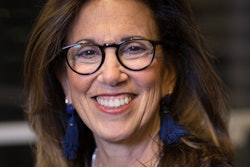 Paulette Brown is the first African-American woman to be president of the American Bar Association. (Photo courtesy of the American Bar Association)
Paulette Brown is the first African-American woman to be president of the American Bar Association. (Photo courtesy of the American Bar Association)When Paulette Brown was growing up in Baltimore, she never dreamed she would become a lawyer. Instead, she wanted to be a social worker, with the end goal of “saving the world,” as she puts it. In Brown’s recollection, her mother always embodied charity and generosity, and those were the values she wanted to elevate in her future career.
“My mother was always involved in a lot of community service, no matter how much money she had,” Brown says. “Even if she only had $10 to give, she would give those $10 to charity. Back in those days it might have been $5. It was the notion that, whatever you had, you shared it, and you always gave back to somebody else.”
Brown was one of four children and the only one of her siblings to attend college. She chose Howard University at the strong encouragement of her school guidance counselor. Although she had dreamed of attending Brown University, it was at Howard that the possibility of becoming a lawyer first occurred to her. The rest was history.
Fast forward several decades and a successful career at a corporate firm, Brown is now the first African-American woman to be president of the American Bar Association (ABA).
In her role as president, Brown hopes to spread awareness about the possibilities of the profession to more young people of color. She plans to visit each of the 50 states, meeting with lawyers and legal organizations. Brown has also made a commitment to visit as many Boys & Girls Clubs as her schedule will allow. By her count, she has already been to 15. Her goal, she says, is to show young people that a career in law is a possibility for everyone.
“I am a first for the American Bar Association and as a result of that I have some unique responsibilities and one of them is to be a role model,” she says. “You can’t aspire to be what you can’t see. So it’s very important to go and let them see me and learn about my life path. I didn’t know any lawyers growing up, there were no lawyers in my family, and yet somehow, here I am.”
Problem at the top
Diversity and representation has never looked so good at the highest echelons of power in the United States. A Black man is the sitting president for the first time in U.S. history. Under his watch, Eric Holder was named U.S. Attorney General and head of the Department of Justice, the first African-American man to hold that honor.
When Holder stepped down in the summer of 2015, he was succeeded in the position by Loretta Lynch, the first Black female AG.
All three achieved success via the same path that many of all races and ethnicities have trod for decades: elite law schools.
Obama is a graduate of Harvard Law School, where, notably, he scored another historic first when he was appointed the first Black president of the prestigious Harvard Law Review in 1990. Holder is an alumnus of Columbia Law School, and Lynch, like Obama, graduated from Harvard Law.
With this sort of representation at the higher levels of government, it would be easy to assume that the tides have turned and that the legal profession is a fully inclusive and diverse place. Yet reality paints a different picture. Despite the sort of high-profile roles held by persons of color with law degrees that have characterized the Obama administration, minority representation in the field is far from widespread.
To better understand the lack of minority representation in law, it is helpful to first lay out the demographic makeup of the country. According to the U.S. Census Bureau, the population was 62 percent White, 13 percent Black and 17 percent Hispanic in 2014.
By contrast, 88 percent of all licensed lawyers were White, 5 percent were Black and 4 percent were Hispanic, according to U.S. Census Bureau data from 2010 reported by the ABA.
Nothing embodies the divergence between the demographic makeup of mainstream America and the legal profession quite as well as “big law.” According to the American Lawyer’s 2015 Diversity Scorecard, only 14.4 percent of lawyers at the nation’s biggest law firms are minorities, and even fewer are partners. For African- Americans, the situation is quite bleak. Only 3 percent of associates are African-American and only 1.8 percent are partners.
“The problem is retention in ‘big law,’ which for associates of color is extremely low,” says Deborah L. Rhode, director of the Center on the Legal Profession at Stanford Law School. “I think the problem is attributable to unconscious racial bias and exclusion from networks of mentoring, support and professional development.”
One of the legal profession’s more notable characteristics is the rigid hierarchy that defines individual law schools. A handful of institutions, such as Stanford, Harvard and Yale, are so selective that a degree from one of them is generally regarded as a guarantee of a graduate’s capabilities. Graduates from those schools tend to be funneled into the top jobs, which has helped create the current circumstance in which all nine Supreme Court Justices attended either Harvard or Yale.
The dearth of minority representation in law is partially attributable to the fact that relatively few underrepresented minorities attend the top law schools. In 2014, 9 percent of all students were African-American at Harvard Law and 7 percent at Yale Law. Asians, by contrast, are highly represented: Harvard Law’s student population is 12 percent Asian and Yale’s is 13 percent, according to the ABA. These numbers, in turn, mean that there are fewer underrepresented minorities in the pipeline to the most high-profile jobs.
Critical numbers
Due to various economic forces and a changing economy, law school enrollment overall dropped nearly 25 percent between 2010 and 2013, according to the ABA. Law school is a risky proposition even in the best economic circumstances: average student debt for a graduate of a private law school hovers around $125,000, as reported by Bloomberg Business, and there is a limited and ever-shrinking pool of corporate jobs that would allow graduates to discharge that amount of debt with their salary.
Notably, minority enrollment in law school actually increased by 5 percent at the schools with lower average LSAT scores during this same period, according to research conducted by Aaron Taylor, a professor at the St. Louis University School of Law.
Today, the schools with the highest proportion of African-American students are at the David A. Clarke School of Law at the University of the District of Columbia (38 percent African-American); North Carolina Central University (53 percent); and Southern University Law Center (54 percent). Charlotte School of Law (36 percent African-American) and the Florida Coastal School of Law (26 percent African-American), which are for-profit institutions, round out the top five, according to U.S. News & World Report.
While an institution such as Harvard can rationalize its price tag with a very high job placement rate and bar pass rate, schools like Florida Coastal and Charlotte cannot say the same. UDC Clarke, which, to its credit, is relatively affordable and selective, nevertheless has a bar pass rate of 54.7 percent and a graduate employment rate of 68.9 percent, according to StartClass, an education research site. Florida Coastal’s bar pass rate was 74.5 percent, as stated in the university’s website, and Charlotte’s was 61.7 percent, according to StartClass.
Charlotte and Florida Coastal were only accredited by the ABA a few years ago and are periodically the subject of critical news articles for their high cost (nearly $43,000 in tuition at Charlotte) and low graduate success rates. Both are owned by the InfiLaw System, a for-profit organization that also owns Arizona Summit School of Law.
Prospective students ought to carefully vet schools and be realistic about the opportunities they offer graduates, says Brian Tamanaha, William Gardiner Hammond Professor of Law at the Washington University School of Law and author of Failing Law Schools. “You might [be able to] get into [a school like Florida Coastal or Charlotte], but it’s not a guarantee you’re going to become a lawyer,” he says. “If becoming a lawyer is your goal, you have to take a really hard look at these schools that claim to be offering opportunities for minority communities, which is how some of these schools are pitching themselves.”
With an average LSAT score for incoming students of 143 at Florida Coastal, 144 at Arizona Summit and 142 at Charlotte, InfiLaw caters to those who might not otherwise have a shot at law school, 145 being the traditional cut-off point for law school admission. Minorities are also a target of InfiLaw’s recruitment efforts. In the summer of 2014, Charlotte School of Law launched a 12-day “Pre-Law Academy” at Livingstone College, a historically Black college in North Carolina. The program is open to rising juniors and recent HBCU graduates. Anyone who completes the program is offered admission to InfiLaw’s three schools.
Providing access to the underrepresented and underserved is a worthy goal in many circumstances, Tamanaha says, but less so when it involves saddling students and graduates with six figures of debt. “The people who are coming to law school already have bachelor’s degrees, so they already have professional opportunities,” he says. If a school does not have a good job placement track record, he says, graduates may find themselves in debt but with job prospects no better than when they started law school.
Brown says that the ABA is committed to improving the diversity numbers in law, which she acknowledges are “really, really not good.” There is no quick fix for the problem, she says. Systemic change will have to start by improving the K-12 and college pipelines that carry—or divert away—students to law school. As she concludes, “The burden is not just on the student; it’s on all of us to create a pathway for them to succeed.”
Catherine Morris can be reached at [email protected].





















